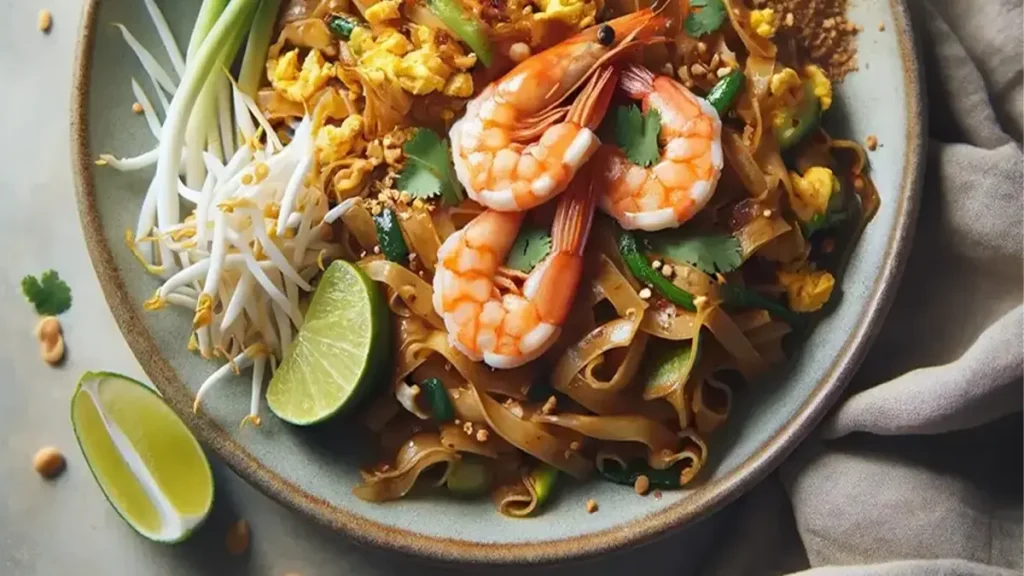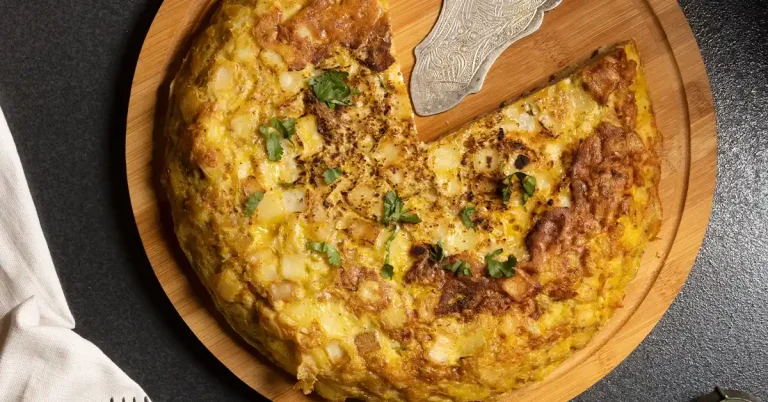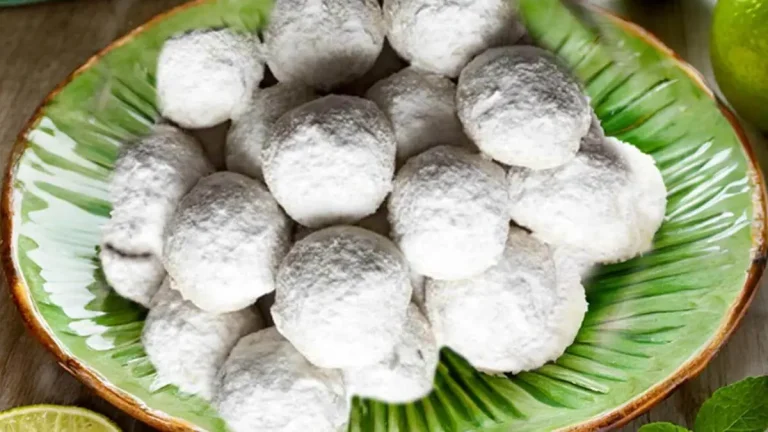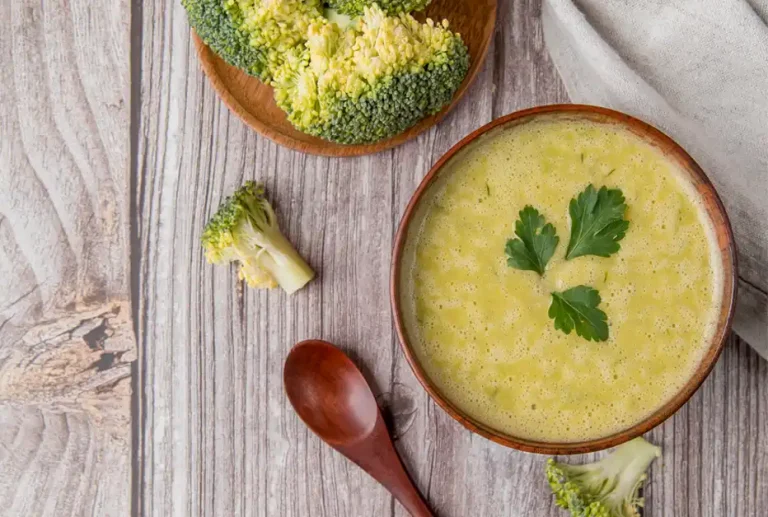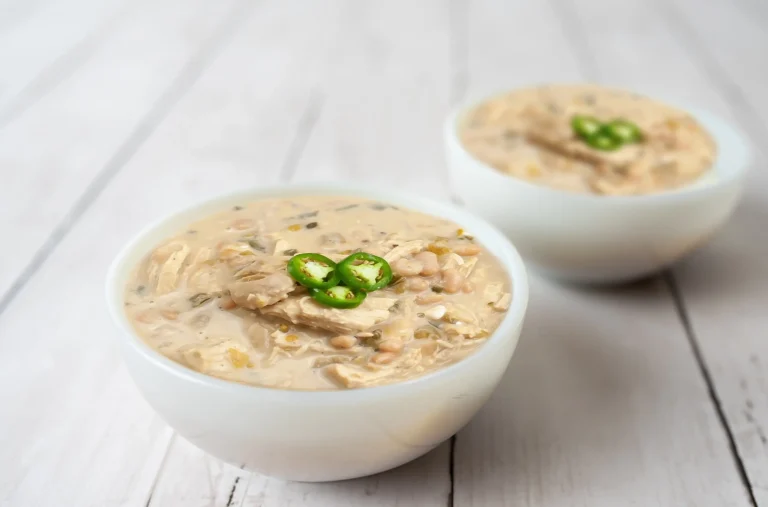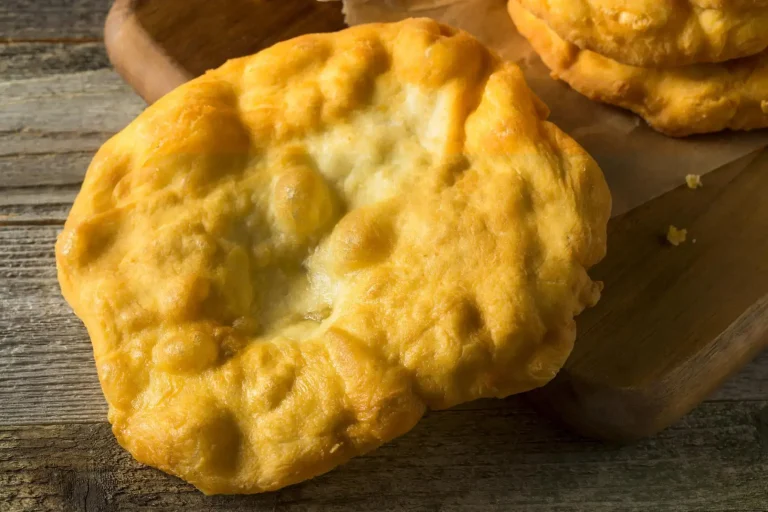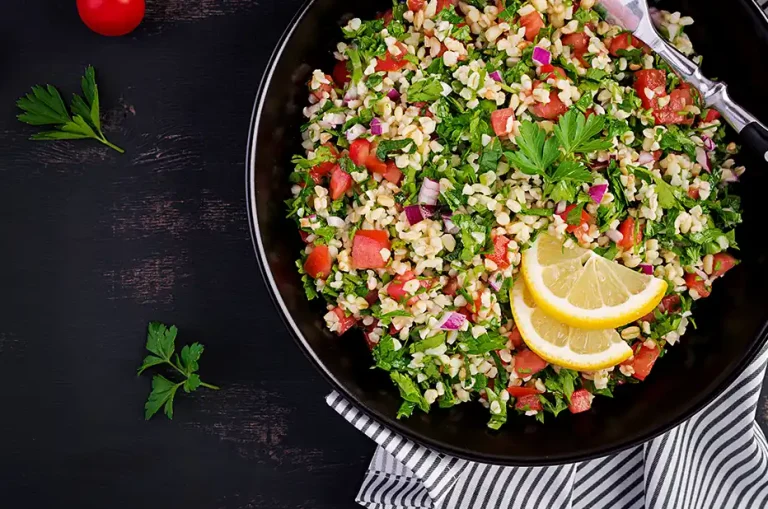Welcome to the vibrant world of Thai cuisine. Let’s dive into Pad Thai, a dish mixing sweet, salty, spicy, and zesty tastes in a perfect balance. Whether you’re a seasoned chef or a curious food enthusiast, learning how to make Pad Thai sauce and the dish itself is an exciting adventure that we are thrilled to share with you.
We’ll explore how to make this beloved dish, teaching you both the recipe and helping you appreciate its unique blend of flavors.Are you ready to transform your kitchen into a Thai street food haven? Let’s whisk our way into the heart of Thai cooking!
Unraveling the Delicious Mysteries of Pad Thai
Join us as we uncover the layers behind Thailand’s most renowned culinary exports. At its heart, what is this dish? This stir-fried noodle dish captures the essence of Thai street food, famous for its lively flavors and the sizzling sounds of cooking. Indeed, it’s a complex tapestry of textures and tastes that has ensnared the palates of food enthusiasts far beyond its borders.
For those looking to indulge in this noodle dish, you might wonder about the calorie content. Interestingly, a quintessential plate holds both the richness of tradition and a significant calorie count. However, with a few tweaks to ingredients, those mindful of their intake can still revel in its deliciousness without overindulgence.
Furthermore, regarding dietary concerns, you may ask about its dairy content. The good news for our dairy-free friends is that this traditional dish is indeed free of dairy products. Consequently, its core ingredients cater to a wide array of dietary preferences, making it an inclusive meal for almost everyone to enjoy without compromise.
Moreover, understanding this dish is about more than just savoring a meal; it’s about experiencing a piece of Thai heritage. Therefore, join us as we continue this exploration into making it at home—where we promise a journey as rewarding as the dish itself is flavorful.
What You Need to Create the Perfect Pad Thai
Embarking on the journey to craft the ultimate Pad Thai means starting with the necessary culinary tools—your ingredients. While the taste might be complex, the shopping list is straightforward. Let’s dive into the essentials and discuss how to tailor your Pad Thai to fit any dietary needs, such as concerns about gluten or peanut allergies. Ours will be an inclusive Pad Thai that everyone can savor.
Essential Ingredients for Pad Thai
Pad Thai’s unique taste comes from a mix of key ingredients. We start with tamarind paste for tanginess, add palm sugar for sweetness, and use fish sauce for salty umami. Lime juice adds a fresh twist.
Tofu or shrimp provide protein, while bean sprouts and green onions bring crunch and color. Eggs scrambled with the noodles give it a classic texture.
Substitute Ingredients for Dietary Restrictions
- If you’re wondering “does pad thai have gluten?”, the answer is it can, depending on the sauce and noodles used. However, there are gluten-free alternatives we can tap into, like tamari in place of traditional soy sauce.
- Concerning peanuts, which are a known allergen, we might ask: “does pad thai have peanut butter?” While often included, we can achieve a similar nutty profile with sunflower seed butter or even a tahini-based sauce, ensuring everyone can enjoy their meal worry-free.
Finding the Right Pad Thai Noodles
The canvas for our vibrant array of flavors is the Pad Thai noodle. Traditional Pad Thai uses rice noodles, which are naturally gluten-free.
However, when selecting noodles, vigilance is key to confirm “are Pad Thai noodles gluten-free?”, especially checking for any cross-contamination warnings if you’re celiac or highly sensitive to gluten. It’s advisable to look for packages marked gluten-free for the safest choice.
In conclusion, finding the perfect noodle transcends dietary needs—it’s equally about texture. Flat, wider rice noodles tend to absorb the sauce more effectively, ensuring each bite is a delightful mix of everything Pad Thai has to offer.
The Cultural Significance and History of Pad Thai
As we embark on a culinary journey to explore how to make Pad Thai sauce, it’s crucial to appreciate the rich tapestry of history woven into this emblematic dish. Pad Thai isn’t just about tantalizing your taste buds; it’s a reflection of Thailand’s resilience and adaptability. Born during a time when the nation sought to consolidate its identity, this dish has soared from its roots as a simple noodle meal to achieve global acclaim. So, what transformed Pad Thai into the cultural phenomenon it is today?
The Evolution of Pad Thai
Historically, Pad Thai was thrust into the spotlight as part of a national campaign to foster a sense of unity and bolster the economy. Rice noodles were both inexpensive and filling, amplifying their appeal during challenging times. Flavors were amalgamated, creating a sauce that deftly balances sweet, savory, and sour elements, turning an everyday meal into an extraordinary symphony of taste. This ingenious mixture is the secret behind many home cooks’ quest to learn how to make Pad Thai sauce that’s as authentic as it is delectable.
Freezing Pad Thai: A Modern Solution
Of course, with our bustling lives, the question arises, can you freeze Pad Thai? Yes, indeed, to the relief of meal-preppers everywhere. Freezing Pad Thai is a testament to its enduring appeal and the modern necessity of convenience. To ensure the dish’s integrity, we recommend separating the sauce and garnishes from the noodles when freezing, then combining them afresh during reheating. This maintains the distinct flavors and textures that are the hallmarks of a perfect Pad Thai.
Preserving the Essence of Pad Thai
Understanding Pad Thai’s origin illuminates its prominence as Thailand’s culinary ambassador. Remember the importance of sauce in the dish? Crafting the quintessential blend of tamarind, palm sugar, and fish sauce is what makes the dish sing. For those wondering, the flexibility of Pad Thai extends to preservation methods. Strategically freezing can extend the life of this beloved dish, retaining its flavor for future enjoyment.
Bringing Pad Thai into Your Kitchen
We continue to unravel the timeless allure of Pad Thai, guiding you through making your very own version, right down to the sauce and storage techniques. Together, we’ll bring a slice of Thailand’s rich history and culture into your kitchen.
Mastering the Art of Pad Thai Sauce

At the heart of every Pad Thai is its alluring sauce, a delectable concerto of flavors that true enthusiasts yearn to perfect. We’re excited to share our secrets on how to concoct this essential blend that is intrinsically dairy-free, ensuring you can relish in its authentic splendor, regardless of dietary preferences. As you embark on this culinary adventure, it’s also invaluable to consider what to serve with Pad Thai to create a meal that dances harmoniously on the palate.
How to Make Pad Thai Sauce
The journey to an impeccable Pad Thai begins with its sauce. Our recipe calls for a careful melange of tamarind paste, the quintessential sour element, mingled with the sweetness of palm sugar and a savory splash of fish sauce. To this trio, we add a hint of spice and a squeeze of lime for that signature zest. Combining these ingredients over a gentle flame will awaken the flavors, preparing them to be tossed with your chosen noodles and toppings.
Authentic vs. Quick Sauce Variations
While we cherish the authentic approach to Pad Thai sauce, we also understand that sometimes time is of the essence. For a swift yet tasty alternative, combine ready-made tamarind concentrate with soy sauce and brown sugar. This quick variation offers a remarkably similar taste profile that complements your noodle dish splendidly, proving that a speedy sauce can still honor the soul of this Thai classic.
Adjusting Spiciness Without Sacrificing Flavor
Personalizing spice levels does not mean you have to forsake the intricate layers of Pad Thai sauce flavors. A dash of chili powder or red pepper flakes can be sprinkled in gradually, finding that sweet spot between mellow and fiery. For those who prefer a milder taste, simply scale back on the heat without compromising the overall symphony of sweet, tangy, and savory that defines this treasured sauce.
Ensuring a Delicious Dairy-Free Pad Thai Experience
For enthusiasts of this classic Thai dish who adhere to a dairy-free diet, it’s comforting to know that the traditional recipe is naturally free from dairy. This aspect makes it a suitable option for individuals with lactose intolerance or those opting to exclude dairy from their diets. Nonetheless, diligence is essential, whether preparing this dish at home or selecting it at a restaurant, to ensure it remains dairy-free.
Here are streamlined tips for a genuine and dairy-free experience:
- Inspect Labels on Pre-made Sauces: Some may contain dairy or its derivatives. Always read the label for ingredients like milk, butter, cheese, or caseinate.
- Opt for Authentic Ingredients: When crafting the sauce yourself, rely on tamarind, palm sugar, and fish sauce, which are inherently free from dairy.
- Careful with Substitutes: Seek dairy-free alternatives that do not compromise the dish’s authentic taste or consistency if modifications are necessary.
- Communicate Dietary Needs: Clearly inform restaurant staff of your dietary restrictions to ensure your dish does not contain dairy.
Exploring the Nutritional Content of Pad Thai
Delving into the nutritional makeup of Pad Thai, we understand that many of our readers are keen to know what goes into their favorite dishes. While indulging in the rich flavors of Pad Thai, it’s natural to ponder about its caloric and carbohydrate contents, and overall health impact. Let’s dissect the components of this beloved Thai dish to provide a clearer picture of its nutritional value.
How Many Calories in Chicken Pad Thai?
For those curious about how many calories in pad thai chicken, a standard serving can vary widely, but on average, it contains around 600 to 1000 calories. The variation largely depends on the portion size and specific ingredients used. It’s important to consider individual nutritional needs when enjoying Pad Thai, as it can be a higher-calorie option in some cases.
Understanding the Carbs in Pad Thai
When it comes to how many carbs in pad thai, a typical plate melds complex and simple carbohydrates. Rice noodles are the main source of carbs in this dish, contributing to the total count which can range anywhere from 40 to 80 grams per serving. Being mindful of your carb intake means you can still savor Pad Thai while maintaining a balanced diet.
Is Pad Thai Bad for You? A Comprehensive Look
The question, is pad thai bad for you, often stems from concerns about dietary balance. While it’s rich in flavors and textures, Pad Thai can be incorporated into a healthy diet when consumed in moderation. The key is to balance it with nutrient-dense foods and to be cognizant of portion sizes, ensuring it complements a varied and nutritious diet plan rather than overpowering it.
What to Serve with Pad Thai: A Guide to Perfect Pairings
Embarking on the Pad Thai adventure doesn’t just end with perfecting those savory, nutty noodles we all adore. The rich tapestry of flavors can be enhanced by pairing our beloved Pad Thai with the right companions.
Whether you’re a seasoned Thai cuisine enthusiast or new to the world of these delectable stir-fried noodles, understanding what to serve with Pad Thai can transform your meal into an extraordinary culinary experience. Let’s not forget our friends with dietary restrictions, for whom the question “are pad thai noodles gluten free?” is a key consideration when curating a meal.
Complementary Side Dishes for Pad Thai
- Crispy Spring Rolls: While a specific recipe for spring rolls wasn’t found, you can inspire your readers with similar appetizers like Grandma’s Hash Brown Casserole for a crispy side.
- Refreshing Papaya Salad: A fresh salad option can be complemented by exploring the Kiwi Smoothie Bowl with Banana and Chia Seeds for a refreshing and healthy side.
- Steamed Vegetables: Directly related content wasn’t identified, but incorporating vegetables into meals is highlighted in recipes like Roasted Vegetables, offering a nutritious balance.
- Cucumber Relish: No direct match, but for a quick, refreshing bite, consider linking to simple and refreshing recipes like the Tomato Cucumber Mozzarella Salad.
Beverage Pairings That Enhance Flavors
- Iced Lemongrass Tea: Specific beverages weren’t listed, but for a unique drink pairing, you might explore creating content around exotic and refreshing beverages that complement Thai spices.
Desserts to Follow a Flavorful Pad Thai Meal
- Mango Sticky Rice: While not directly mentioned, you could suggest desserts that pair well with Thai food, such as Coconut Lime Mexican Wedding Cookies for a sweet end to the meal.
- Coconut Ice Cream: No direct link, but emphasizing tropical flavors in desserts like the coconut in the cookies above could serve as a guide for readers looking for a cool dessert.
Incorporating these harmonious pairings into your Pad Thai dining experience will surely impress your guests and satisfy even the most discerning palates. Now go forth and feast with these flavorful allies by your side!
Storing and Savoring Leftover Pad Thai
Enjoying this dish a second time around is one of the delights of cooking Pad Thai. Here, we’ll guide you on how to properly store and reheat it, preserving its delicious taste and texture. Initially, ensure it’s stored correctly to maintain freshness. Place any leftovers in an airtight container and refrigerate, where they can remain fresh for up to three days.
For reheating, a gentle approach is key to avoid drying out the noodles. While the microwave offers speed and convenience, stovetop reheating is superior.
To revive the noodles’ tenderness:
- Take the dish out of the fridge.
- Add a little water to a pan over medium heat.
- Put the noodles in the pan, stirring gently until they’re evenly warmed.
Should you have leftovers beyond a few days, freezing is a viable option. Freezing may alter the noodles’ texture slightly, but they can be kept for up to a month. When ready to enjoy again, thaw and reheat gently in a pan to best preserve its quality. This careful process ensures your dish remains a source of culinary delight.
Conclusion
As we end our journey with Pad Thai, think about why this dish is so loved. We’ve highlighted the importance of using authentic ingredients to give the dish a true Thai flavor. We’ve also highlighted the magic of mixing the right flavors to create a perfectly balanced and zesty sauce. With this knowledge, you’re ready to make a genuine Thai classic at home.
FAQ
What is Pad Thai?
It’s a beloved traditional Thai stir-fried noodle dish that incorporates eggs, tofu, tamarind pulp, fish sauce, garlic or shallots, red chili pepper, palm sugar, and lime wedges. Typically served with shrimp or chicken, it’s garnished with roasted peanuts, fresh herbs, and bean sprouts for added flavor and texture.
How can I make my own Pad Thai sauce?
Begin with tamarind paste, fish sauce, palm sugar, and a touch of chili powder or sauce for some heat. Combine these ingredients in a saucepan and warm gently until the sugar dissolves. Adjust the mix to get the perfect balance of sweet, sour, and salty to suit your taste.
What can I serve with Pad Thai?
Consider side dishes like cucumber salad, spring rolls, or steamed vegetables to complement the meal. For beverages, iced jasmine tea or light beers are excellent choices, and a tropical fruit salad makes for a refreshing dessert.
Is Pad Thai dairy-free?
Indeed, the traditional recipe is dairy-free, relying on tamarind, fish sauce, and other non-dairy components for its unique flavors. Always verify labels or ask when ordering if you’re concerned about the inclusion of dairy in modified versions.
Is Pad Thai unhealthy?
When enjoyed as part of a balanced diet, it can be a healthy choice. Its nutritional value depends on the cooking method and the proportions of ingredients used. Incorporating a variety of vegetables and lean protein, while limiting the oil for stir-frying, can enhance its healthfulness.
How can I reheat Pad Thai?
The optimal method is to warm it gently in a pan over medium heat, adding a little water to keep it from drying out. Alternatively, microwaving in short intervals, stirring in between, ensures even heating, though this might slightly alter the noodle texture.
How many carbohydrates are in Pad Thai?
The carbohydrate content can vary, but a standard serving size might contain about 40-70 grams, primarily from the noodles and sauce components.
How many calories are in a plate of Chicken Pad Thai?
Calorie content can vary widely, but a typical restaurant serving might range from 300-500 calories per cup. Given that portions are often larger, total calories can be higher for a full plate.
How long does Pad Thai last in the fridge?
When stored properly in an airtight container, it can remain fresh in the fridge for up to 3 days. For optimal quality, refrigerate within 2 hours of cooking.
Does Pad Thai typically contain peanut butter?
While peanuts are a common garnish, peanut butter is not a traditional ingredient in the sauce or the dish. Some recipes or variations might include it for added richness and nutty flavor.
Can you freeze Pad Thai?
Yes, freezing is possible, though the texture of the noodles may be slightly altered when thawed and reheated. For best quality, store in an airtight container and freeze for up to 3 months.
Does Pad Thai have gluten?
The traditional version made with rice noodles is naturally gluten-free. However, since soy sauce often contains gluten, it’s advisable to use tamari or a gluten-free soy sauce if avoiding gluten. Always check ingredients if you have gluten sensitivities, as some preparations may include gluten.
Are Pad Thai noodles gluten-free?
Yes, rice noodles, typically used in this dish, are gluten-free. However, for those highly sensitive to gluten or with celiac disease, it’s recommended to verify the package to ensure no gluten-containing ingredients have been added.
For more detailed information on gluten-free diets and how to safely enjoy gluten-free meals like Pad Thai, visit the Celiac Disease Foundation here.
Recipe Tips
- Pad Thai Sauce: Combine tamarind paste, fish sauce, palm sugar, and lime juice. Adjust sweetness, sourness, and saltiness to taste.
- Gluten-Free Adaptation: Use rice noodles and substitute soy sauce with tamari to keep the dish gluten-free.
- Nut Allergy Friendly: Replace peanuts with crushed, roasted sunflower seeds or use a nut-free sauce like tahini for a similar texture and taste without allergens.
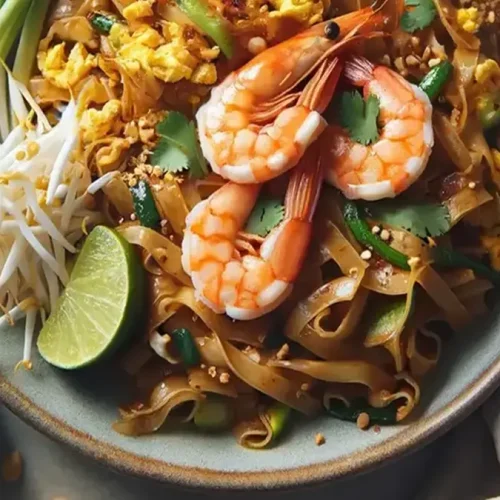
Pad Thai
Ingredients
- 8 oz flat rice noodles
- 2 tablespoons oil
- 1 pound chicken breast thinly sliced (or tofu for a veggie option)
- 1 cup of fresh bean sprouts
- 1 red bell pepper thinly sliced
- 3 green onions chopped
- 2 eggs lightly beaten
- 1/2 cup roasted peanuts crushed
- 1 lime cut into wedges
Sauce
- 3 tablespoons fish sauce
- 1 tablespoon soy sauce
- 5 tablespoons brown sugar
- 2 tablespoons tamarind paste
- 1 teaspoon chili powder adjust to taste
Instructions
- Cook rice noodles according to package instructions, then drain and set aside.
- Heat oil in a large skillet over medium-high heat. Add chicken (or tofu) and cook until browned. Remove from skillet and set aside.
- In the same skillet, add the red bell pepper and sauté for a few minutes. Add the green onions and bean sprouts, cooking for an additional 2 minutes.
- Push the veggies to the side of the skillet, pour in the beaten eggs, and scramble until fully cooked.
- Return the chicken (or tofu) to the skillet. Add the cooked noodles and pour the sauce over the top. Toss everything together and cook for another 2-3 minutes, ensuring the noodles are heated through and everything is well combined.
- Serve hot, garnished with crushed peanuts and lime wedges on the side.
Notes
- Pad Thai Sauce: Combine tamarind paste, fish sauce, palm sugar, and lime juice. Adjust sweetness, sourness, and saltiness to taste.
- Gluten-Free Adaptation: Use rice noodles and substitute soy sauce with tamari to keep the dish gluten-free.
- Nut Allergy Friendly: Replace peanuts with crushed, roasted sunflower seeds or use a nut-free sauce like tahini for a similar texture and taste without allergens.

